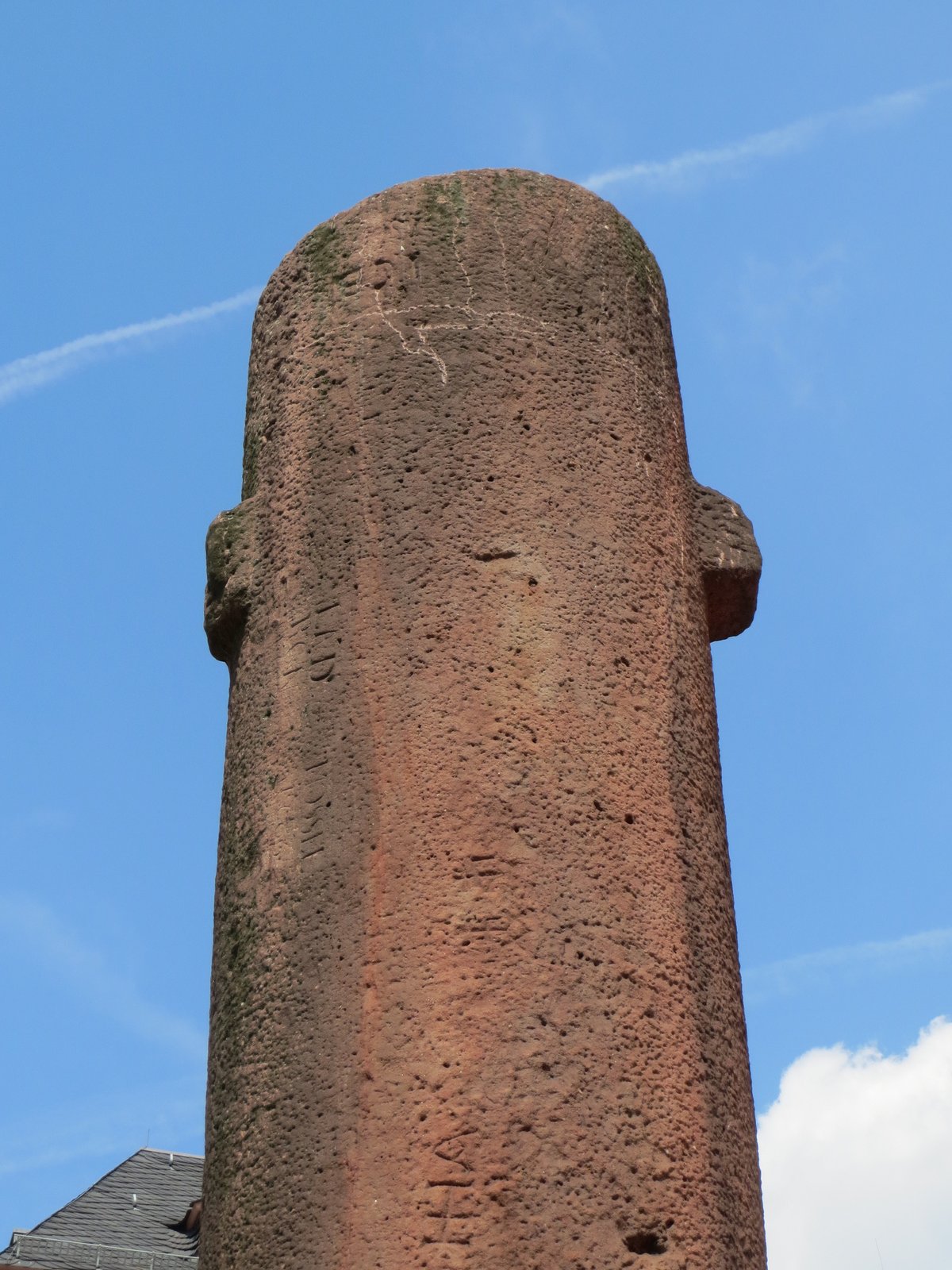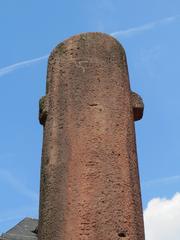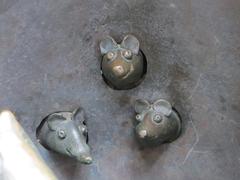
Heunensäule Mainz: Visiting Hours, Tickets, and In-Depth Travel Guide
Date: 14/06/2025
Introduction: The Legacy of the Heunensäule
Located at the heart of Mainz, Germany, the Heunensäule is a monumental red sandstone column that encapsulates more than a thousand years of the city’s vibrant history. Towering over Liebfrauenplatz near the Mainz Cathedral (Mainzer Dom), this ancient monolith stands as a silent witness to Mainz’s Roman roots, medieval ambitions, and modern resilience. Once intended for the 11th-century reconstruction of the cathedral after a devastating fire, the column’s journey from the Odenwald quarries to its present urban setting weaves together legends, artistry, and enduring civic spirit.
The Heunensäule is not just a relic—it is an interactive canvas adorned with bronze reliefs recounting Mainz’s triumphs, tragedies, and traditions. As an open-air monument, it is accessible to all, free of charge, and serves as a focal point for festivals, markets, and daily city life. This comprehensive guide provides everything you need to know about the Heunensäule: its origins, historical context, detailed features, visitor logistics, and tips for making the most of your visit.
For official information and further resources, consult Mainz Tourismus, Stadt Mainz, and Deutsche Stiftung Denkmalschutz.
Table of Contents
- Introduction
- Origins and Historical Background
- Medieval Mainz and the Holy Roman Empire
- Abandonment, Rediscovery, and Modern Placement
- Artistic and Architectural Features
- Visitor Information
- Practical Tips for Visitors
- Visitor Reviews and Experience
- Frequently Asked Questions (FAQ)
- Conclusion
- Sources
Origins and Historical Background
The Heunensäule derives its name from the German word “Heunen” (giants), reflecting both its monumental scale—about 6.4 meters high and weighing between 16 and 27 tons—and the legends that surround it. Quarried in the early 11th century from the Odenwald or Miltenberg region (Mainz Tourismus), the column was intended to be part of the rebuilt Mainz Cathedral after the catastrophic fire of 1009. Under the vision of Archbishop Willigis, the project required transporting massive stone columns over treacherous terrain—a feat of medieval engineering and ambition.
However, the Heunensäule was never integrated into the cathedral, likely due to logistical challenges or evolving architectural plans (Stadt Mainz). It remained abandoned near the Rhine for centuries, shrouded in local folklore about giants and hidden treasures.
Medieval Mainz and the Holy Roman Empire
In the 11th century, Mainz was a major ecclesiastical and political hub, central to the Holy Roman Empire. The cathedral itself was both a religious beacon and a site of imperial coronations. The Heunensäule’s intended placement within the cathedral symbolized the city’s religious and political significance (Deutsche Stiftung Denkmalschutz). The immense effort to quarry and transport such monolithic columns underscored Mainz’s aspirations and capabilities during this period.
Abandonment, Rediscovery, and Modern Placement
The Heunensäule lay forgotten for centuries, eventually becoming a source of myth and local legend. In the 19th century, amidst a renewed interest in medieval heritage, the column was rediscovered and gradually recognized as a symbol of Mainz’s resilience. In 1975, a Heunensäule was gifted from Miltenberg to Mainz for the cathedral’s millennium celebration and installed on Liebfrauenplatz, directly in front of the cathedral (mainzund.de). The column has since become a central landmark in the city’s urban landscape.
Artistic and Architectural Features
Sandstone and Dimensions
The column is hewn from a single block of robust red sandstone, standing 6.4 meters tall and approximately 1.2 meters in diameter. Its unfinished state, visible tool marks, and weathered surface offer direct insight into medieval stonemasonry and Romanesque architectural tradition (mainzund.de).
Bronze Mantle and Reliefs
The Heunensäule’s base is encircled by a bronze mantle, crafted by Gernot Rumpf, that transforms the monument into a multidimensional narrative. The reliefs depict Mainz’s journey from Roman times, through its powerful bishopric era, French occupation, and imperial visits. Highlights include:
- Roman Heritage: Legionary helmet symbolizing Mainz’s ancient origins.
- Ecclesiastical Power: Bishop’s mitre denoting religious significance.
- Carnival Tradition: Jester’s cap for the city’s famous Fastnacht.
- Mainz Wheel (Mainzer Rad): Iconic city symbol in historic and modern forms.
- Kopfbedeckungen (Headgear): Diverse historical headgear representing different eras.
- Commemoration of Tragedy: Reliefs referencing the destruction of the Jewish community and WWII bombings, reminding visitors of the city’s endurance (Stadt Mainz).
Urban Integration and Restoration
The Heunensäule stands atop a sand trap (Sandfang), part of the city’s drainage infrastructure, facilitating both preservation and modern utility. Restoration efforts—including the significant 2024 cleaning and stabilization—ensure the monument’s longevity (Deutsche Stiftung Denkmalschutz).
Visitor Information
Location and Accessibility
- Address: Liebfrauenplatz (Domplatz), Mainz—directly in front of Mainz Cathedral.
- Public Transport: Easily accessible by tram or bus (“Höfchen/Markt” and “Dom/Römerpassage” stops); a 15-minute walk from Mainz Hauptbahnhof.
- Parking: Nearby underground garages, such as “Parkhaus am Theater” or “Parkhaus Rathaus” (Wanderlog).
Visiting Hours and Tickets
- Hours: The Heunensäule is located outdoors and accessible 24/7, every day of the year.
- Tickets: No entrance fee or ticket is required.
Guided Tours
- Options: Free public access; guided tours available via the Mainz tourism office and local operators, often including the Heunensäule, Mainz Cathedral, and Gutenberg Museum.
- Booking: Online or at city tourist information centers.
Best Times and Photography Tips
- Best Times: Spring and autumn offer pleasant weather; early mornings and evenings provide dramatic lighting and quieter surroundings (Wanderlog).
- Photography: The red sandstone and bronze reliefs are best captured during golden hour or when illuminated at night.
Nearby Attractions
- Mainz Cathedral (Mainzer Dom): Romanesque masterpiece with centuries of history.
- Gutenberg Museum: Celebrates the inventor of movable type printing.
- Rhine Promenade: Scenic riverside walks.
- Markets and Cafés: Domplatz is surrounded by eateries and shops, enhancing your visit.
Events and Local Culture
The Heunensäule is a focal point for city events, including the Mainz Christmas Market, Fastnacht (Carnival), and Johannisnacht. These festivities infuse Domplatz with music, local food, and vibrant community spirit (Allevents.in).
Practical Tips for Visitors
- Accessibility: The square is flat and paved, suitable for wheelchairs and strollers.
- Restrooms: Available nearby.
- Weather: Bring water and sun protection during summer; winters can be chilly but festive.
- Safety: Domplatz is generally safe, but remain mindful during crowded events.
Visitor Reviews and Experience
Visitors praise the Heunensäule for its imposing presence, artistic storytelling, and seamless integration into Mainz’s urban life. Many recommend guided tours or using informational apps to deepen the experience due to limited on-site signage (Wanderlog).
Frequently Asked Questions (FAQ)
Q: What are the Heunensäule visiting hours?
A: Open-air monument, accessible 24/7.
Q: Is there an entrance fee to see the Heunensäule?
A: No, it is free to visit.
Q: Are guided tours available?
A: Yes, many city tours include the Heunensäule. Check with Mainz tourism office.
Q: Is it wheelchair accessible?
A: Yes, Domplatz is fully accessible.
Q: What’s the best time to visit?
A: Daytime for detail, evenings for ambiance; festive periods like Christmas and Fastnacht are especially lively.
Conclusion
The Heunensäule is more than just a column—it is a living chronicle of Mainz’s architectural ingenuity, cultural resilience, and communal spirit. From its medieval origins as a cathedral support to its modern role as a civic symbol, the monument connects visitors to the city’s layered past and vibrant present. Whether you visit during a bustling festival or a peaceful morning, the Heunensäule offers a unique and accessible window into Mainz’s enduring legacy.
Plan your visit today, download the Audiala app for immersive audio tours, and explore Mainz’s rich historical landscape.




































































































































